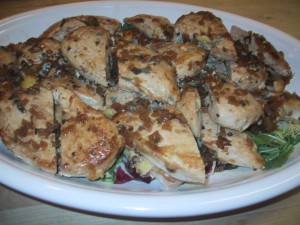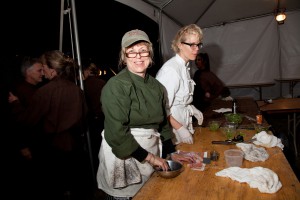Chicken….it seems like the perfect food, right? Reputed to be simultaneously budget-friendly, easy to prepare and popular; many clients ask for it on their event menus. The surprising fact about chicken in a banquet context, it is often neither inexpensive nor easy to prepare. How many bad “mystery” chicken entrees have you endured at weddings, parties, galas and BBQ’s? Who can forget the boneless, skinless roast chicken breast that seems to grow in your mouth as you chew? How many times can you remember tasting chicken at a large event that was savory, flavorful, juicy and tender?
In the kitchen, chicken goes from hero to zero in a matter of minutes. The most popular form, the skinless and boneless breast filet, has no internal fat to baste the meat as it cooks. Thought to be a frequent source of food poisoning, chicken must be cooked to an internal temperature of at least 165F. This almost guarantees that a breast filet will be dry and tasteless. On the other hand, legs and thighs are perceived to be less elegant, more suited to a picnic than to fine dining. In fact, a chicken thigh is the one piece of the bird that stands the greatest chance of remaining supple and juicy when cooked to a safe temperature. However, it is often red or pink at the bone, even when cooked to the proper serving temperature, causing guests to suspect it is undercooked or even raw.
Chicken’s saving grace as a banquet entrée is its portion size. A single 6-8 ounce portion (breast or thigh) serves one guest. How many other proteins arrive in the kitchen already portioned? If you choose to serve whole roast chicken at a function, you are faced with either carving to order or hacking the bird up Chinese-style into serving portions. Neither option is particularly attractive or easy to serve to a large group, especially if the meal is served plated.
In an attempt to add flavor to a commodity boneless, skinless chicken filet, chefs resort to stuffing, pounding, stewing, frying or saucing. The net result is stunningly predictable; dry and mealy meat swimming in a flavorful fat or sauce. In kitchen parlance, boneless, skinless becomes “b/s,” and we all know what B. S. really means. I have yet to meet a chef that really enjoys preparing boneless, skinless chicken filets. While enjoying fine dining status in the early 1980’s (as the chicken paillard, a thinly pounded cutlet seared and served hot from the pan with a light sauce), this cut is noticeably absent on restaurant menus outside the mainstream chains. Favored by cardiologists and dieticians for its low level of fat, this cut is almost impossible to serve flavorfully outside the a la minute environment of a small restaurant. The only way to add moisture is to brine, adding enough salt to send a chill down the spine of any self-respecting health professional. Yet are Americans just accustomed to dry, white chicken meat on their plates?
At a recent event, we prepared an apple stuffed boneless, skinless breast roulade; roasted, sliced and sauced with a cider-mustard beurre blanc. The guests consumed it with gusto, but while tasting a slice in the kitchen, I personally found it dry, mealy and insipid despite the well balanced flavors in the sauce. As an experiment, I prepared the same dish using skin-on boneless breast filet and boneless, skin-on chicken thighs. The skin-on breast was juicier, but still largely dry. The skin-on thighs were unctuous, savory and tender. The crisp skin provided a necessary counterpoint to the tender meat and moist stuffing. It was almost as if the meat of the breast filet actually pulled moisture out of the stuffing, leaving the entire entrée somehow unfinished, even after the addition of sauce. The thigh, on the other hand, remained moist and delectable even after three days in the cooler and reheating in the microwave.
We use primarily California raised, free-range chicken for our dishes. Since these chickens are active, and consume feed that is supplemented by foraging, the meat is more deeply colored than the factory farmed counterpart. Because these chickens are larger, they are often slaughtered at a younger age, and their bones are softer, leaching hemoglobin into the surrounding muscle, especially in the legs and thighs. What this means is that the dark meat of these birds resembles duck or turkey more than chicken. Americans are taught from childhood to fear raw chicken, and they are also taught that the primary indication of raw chicken is red or “bloody” meat near the bones. However, per the USDA, “Darkening of bones and meat around the bones occurs primarily in young (6-8 weeks) broiler-fryer chickens. Since the bones have not calcified or hardened completely, pigment from the bone marrow seeps through the bones and into the surrounding area. Freezing can also contribute to this darkening. This is an aesthetic issue and not a safety one. The meat is safe to eat when all parts have reached a safe minimum internal temperature of 165 °F as measured with a food thermometer.” (source: http://www.fsis.usda.gov/Fact_Sheets/Color_of_Meat_&_Poultry/index.asp#15)
As a requirement of our food safety training, chefs are taught not only to cook potentially hazardous foods, such as poultry, to the correct finish temperature; but we are also taught to record the cooking temperature, conditions, time and finish temperature in order to maintain a controlled process . As a result, we are very aware of how chicken is cooked before serving to the customer. Yet time and again, chicken legs and thighs are sent back as “underdone” or “raw” by guests. In our kitchen, we actually increase the cooking time and look for a finish temperature of 180F at the bone in legs and thighs, hoping to produce a finished dish that is delicious as well as visually appealing to the customer.
When a client begins menu discussions, chicken is almost always on the list. As a result of our experience, we have begun to discuss not only the presentation and the flavors with our customers; we also discuss the cuts and methods of preparation. An added complication today is that many recipes for boneless skinless breast filets also include a crust or coating of nuts to make up for the lack of fat in the meat itself. With the emergence of nut allergies as a concern, we have been forced to look for new ways to add flavor and texture. Many of our tastiest recipes for chicken are not pretty on the plate or platter. In buffet service, the use of chafing dishes and other means of keeping chicken at a safe serving temperature almost guarantee it will be overdone for at least half of the guests. We have found the best way to preserve the texture and flavor of chicken on a buffet is to serve it over a vegetable sauté or braised white beans with greens. The moisture in these items helps maintain moisture in the chicken, and the layer of food underneath insulates the chicken itself from the drying heat of the pan. For plated meals, we prefer roulades or stuffed pieces that can be shingled or cut offset to display the filling, then sauced. Our ultimate aim is to see that our customers get a preparation that will meet or exceed not only their expectations, but those of their valued guests. This means we do a lot of talking about chicken, and we ask a lot of questions.
Ultimately, a tasting may be the best way we, as caterers, can address the chicken conundrum. Under these conditions, we can serve the same recipe prepared with different cuts, or with skin on or off. When a customer actually tastes the difference, most agree with our recommendations and swap out the boneless skinless breast filet for another option. After all, we really want the same thing; happy and satisfied guests who feel they have been treated to an exceptional and celebratory meal, while still respecting the customer’s budget preferences.



